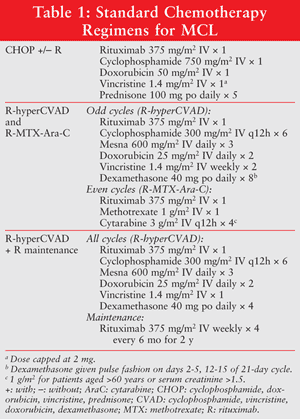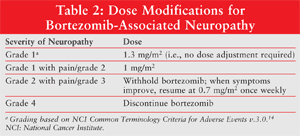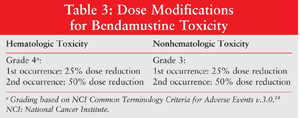US Pharm. 2009;34(9)(Oncology suppl):12-14.
ABSTRACT: Mantle cell lymphoma is an aggressive disease that carries an unfavorable prognosis. Historically, chemotherapy alone has produced only marginal increases in survival benefit. Recently, the use of more cytoreductive treatments and the application of targeted therapies have produced significant increases in response. The data emerging from recent and ongoing clinical trials indicate a positive trend toward improved prognosis and survival in patients with this rare and complex disease.
Non-Hodgkin's lymphoma (NHL) encompasses a diverse group of cancers originating in B, T, or natural killer lymphocytes. More than 30 subtypes have been identified and categorized as indolent, aggressive, or highly aggressive based on clinical characteristics.Mantle cell lymphoma (MCL) is considered an aggressive form of lymphoma. It comprises about 6% of all cases of NHL, with an incidence rate of 2 to 3 per 100,000 per year. MCL is more prevalent in males and in individuals over the age of 60. Most patients have disseminated disease at diagnosis, with common sites of extranodal disease being the bone marrow, gastrointestinal tract, and spleen.1
MCL has the worst prognosis of any B-cell NHL subtype because it carries the unfavorable characteristics of both indolent and aggressive lymphomas. Median overall survival (OS) for MCL without treatment is 3 to 5 years, versus 7 to 10 years for indolent lymphoma.1 In this way, MCL behaves like an aggressive lymphoma, yet does not respond to chemotherapy as well as other aggressive lymphomas. As is the case with indolent lymphomas, chemotherapy has not produced “cures” or durable remissions in MCL. Accordingly, the need for effective front-line and salvage therapy for MCL is the focus of researchers and clinicians.
There is a small, rare subset of MCL with an indolent course and relatively long survival without treatment.2 This review discusses the aggressive form of MCL, which requires treatment upon diagnosis.
DIAGNOSIS
The diagnosis of MCL is based on histologic, immunophenotypic, and cytogenetic characteristics. Cyclin D1 overexpression resulting from the t(11;14) (q13;q32) translocation is the hallmark of MCL and allows clinicians to distinguish MCL from other subtypes of NHL. Recently, cyclin D2 and cyclin D3 overexpression in the absence of cyclin D1 have been observed in cases of MCL. Immunohistochemical staining usually reveals cells that are CD20-positive, CD22-positive, CD5-positive, immunoglobulin (Ig) M-positive, and IgD-positive.1-3
TREATMENT
Newly Diagnosed Disease
In searching for front-line treatments for MCL, researchers first investigated anthracycline-based regimens used in other lymphoma subtypes. An early study showed that cyclophosphamide, doxorubicin, vincristine, and prednisone (CHOP) chemotherapy (TABLE 1) produced a complete remission (CR) rate of 58%, but OS of only 37 months--not a great improvement over survival rates without cytotoxic treatment.4 The CD20 antibody rituximab, when added to traditional chemotherapy, has improved response rates for CD20-positive lymphomas.5 Likewise, in MCL, R (rituximab)-CHOP (TABLE 1) resulted in a superior overall response (OR) and CR versus CHOP (94% vs. 75% and 34% vs. 7%), but failed to show a benefit in progression-free survival (PFS).6

The M. D. Anderson Cancer Center has utilized a more cytoreductive regimen--R-hyperCVAD (cyclophosphamide, vincristine, doxorubicin, dexamethasone)/R-MTX (methotrexate)-Ara-C (cytarabine)--for untreated aggressive MCL (TABLE 1). A single-center study of this regimen yielded an OR and CR of 97% and 87%, respectively.7 Patients' 3-year OS was 82%, higher than results with R-CHOP. Patients under the age of 65 had a better 3-year OS than patients over 65 (85% vs. 75%; P = .05). Higher rates of dose-limiting hematologic toxicity were seen after R-MTX-Ara-C than after R-hyperCVAD. In 2007, the Southwest Oncology Group attempted to replicate these results in a multicenter trial of newly diagnosed patients receiving R-hyperCVAD and R-MTX-Ara-C. 8 This trial also yielded a high rate of CR (58%). Survival data from this trial have not yet matured.
After the M. D. Anderson trial, the Wisconsin Oncology Network performed a small phase II study to investigate the use of a modified hyperCVAD regimen (TABLE 1).9 The goal was to decrease toxicity and increase PFS by eliminating methotrexate and cytarabine and adding a maintenance regimen of rituximab. At study completion, 77% of patients had an OR and 64% had a CR. At 2 years, PFS and OS were 59% and 77%, respectively. This regimen produced higher CR rates than trials with R-CHOP and median PFS was comparable to that in patients who received consolidative autologous stem cell transplantation (ASCT), despite an older patient population.
Without prospective randomized trials comparing these regimens directly, the superior choice is unknown. However, available data allow clinicians to individualize patients' therapy based on their disease characteristics, age, and performance status. The National Comprehensive Cancer Network (NCCN) guidelines recommend CHOP with or without rituximab in selected older patients who cannot tolerate more intensive therapy. Treatment with R-hyperCVAD and MTX-Ara-C also is considered front-line therapy for newly diagnosed MCL patients. For patients over the age of 65 who require more aggressive treatment, modified R-hyperCVAD with rituximab maintenance is recommended. These regimens are among those more commonly employed, although additional regimens demonstrating efficacy have been included as first-line options in the NCCN guidelines for MCL.
Relapsed or Refractory Disease
Despite a high rate of response to front-line treatment, most patients will relapse. Therefore, treatment of progressive disease has become increasingly important. Various new agents have shown activity in relapsed or refractory MCL, and several clinical trials are underway.
Bortezomib: The first agent approved by the FDA for relapsed or refractory MCL, bortezomib has a novel mechanism of action known as reversible proteasome inhibition.10 Proteasomes are large protein complexes responsible for the degradation of intracellular proteins. Inhibition of the 26S proteasome prevents proteolysis, affecting multiple cell-signaling cascades and disrupting normal homeostatic mechanisms, leading to cell death. Bortezomib's activity in MCL may occur through the inhibition of nuclear factor kappa B (NF-kB), which stimulates cyclin D1 expression.11 In a phase II multicenter trial of 155 patients with progressive MCL after at least one prior therapy, bortezomib monotherapy produced an OR of 33%, with 8% of patients achieving a CR. Median duration of response was 9.2 months for all patients and 13.5 months in those with a CR.12
Bortezomib is approved for MCL patients who have received at least one prior therapy. It is administered IV on days 1, 4, 8, and 11 of a 21-day cycle at a dose of 1.3 mg/m2. Each dose of bortezomib causes proteasome inhibition for up to 72 hours. More frequent dosing has led to increased toxicity. Peripheral neuropathy is a reversible and dose-dependent toxicity of bortezomib. Monitoring for neurotoxicity is important considering that the majority of relapsed patients have received prior treatment with vincristine. Studies have shown that timely dose reductions can prevent worsening of symptoms and allow patients who are responding to continue with treatment (TABLE 2).13 In clinical trials, thrombocytopenia was common but did not result in treatment delays if patients had normal platelet counts at baseline. Patients with liver dysfunction should be closely monitored for additional toxicity since bortezomib is metabolized and cleared hepatically.

Bendamustine: This agent has been used in the oncologic setting in Europe for more than 30 years. Structurally, bendamustine is a combination of an alkylating agent and a purine analog and works by covalently binding to DNA, forming intrastrand crosslinks, and causing cell death. It exhibits similar or greater potency than cyclophosphamide and has been shown to be active against cell lines resistant to alkylating agents in vitro. The addition of rituximab shows synergistic activity in animal models and allows induction of apoptosis in NHL cells with lower doses of bendamustine in vitro.15
Bendamustine is FDA-approved for indolent B-cell NHL that has progressed during or within 6 months of treatment with rituximab or rituximab-containing regimens; it is currently being studied in aggressive lymphomas. Bendamustine and rituximab (BR) therapy was first evaluated clinically in a phase II trial that included newly diagnosed and relapsed MCL patients. The OR was 75%, the CR was 50%, and median PFS was 18 months.16 A more recent phase II study replicated these results in 12 MCL patients with relapsed disease who exhibited an OR of 92%, CR of 42%, and median PFS of 23 months.17 Unlike the previous trial, this study included a large number of patients who were refractory to previous rituximab therapy.
The recommended dose of bendamustine in indolent NHL is 120 mg/m2 given on days 1 and 2 of a 21-day cycle. In clinical trials of BR, the dose was reduced to 90 mg/m2 on days 2 and 3 of a 28-day cycle. In NHL studies, 98% of patients experienced grade 3 to 4 myelosuppression; dose modifications for hematologic toxicity are recommended (TABLE 3).16-18 Patients who experience infusion reactions with the first cycle of bendamustine should be premedicated with antihistamines, antipyretics, and corticosteroids prior to administration of subsequent cycles. Secondary malignancies after bendamustine treatment have been reported, but many patients had previously received an alkylating agent. Medications that induce or inhibit CYP450 1A2 should be avoided since the active metabolites of bendamustine are formed through this system. The use of bendamustine is contraindicated in patients with creatinine clearance less than 40 mL/min, aspartate aminotransferase/alanine aminotransferase greater than or equal to 2.5 times the upper limit of normal (ULN), or total bilirubin greater than or equal to 1.5 times the ULN owing to insufficient clinical data in these populations.19

Other Agents: Several other agents are being investigated for relapsed MCL. Thalidomide and lenalidomide are immunomodulatory agents that may have a place in MCL treatment owing to their indirect effects on NF-kB. A phase II study reported that thalidomide in combination with rituximab produced an OR and CR of 81% and 31%, respectively, in relapsed/refractory MCL patients.20 A preliminary report from an ongoing international trial of lenalidomide in relapsed/refractory aggressive NHL shows an OR of 28%. Data regarding response rates in the subgroup of MCL patients are pending.21
Temsirolimus, an agent that exerts its cytotoxic effects by inhibiting the mammalian target of rapamycin kinase (MTOR), may be efficacious against MCL owing to MTOR's role in regulating cyclin D1 translation. A phase II trial of relapsed/refractory MCL patients showed that single-agent temsirolimus had an OR of 38%.22
Cladribine is a newer purine analog that has demonstrated activity in MCL. A phase II trial in newly diagnosed or relapsed MCL patients yielded an OR of 58%.23
The NCCN recommends the above agents for second-line treatment of MCL. Choice of agent should be based on disease characteristics, consideration of toxicities resulting from prior treatment, and patient preference.
STEM CELL TRANSPLANTATION
The high relapse rate after front-line therapy led the European MCL Network to study consolidative ASCT. MCL patients who had achieved complete or partial remission after CHOP or CHOP-like induction therapy were randomized to consolidative treatment with myeloablative radiation followed by ASCT or interferon maintenance.24 ASCT patients had longer PFS than interferon patients (39 vs. 17 mo), but similar 3-year OS (83% vs. 77%). M. D. Anderson has found a potential for long-term PFS and possible “cures” in patients given rituximab as part of their induction regimen prior to consolidative ASCT.25
The NCCN guidelines recommend high-dose therapy with ASCT as first-line consolidation for MCL. Allogeneic SCT (myeloablative or nonmyeloablative) may be curative in lymphoma patients, but is associated with significant transplant-related morbidity and mortality and is recommended by the NCCN as second-line consolidation.
REFERENCES
1. NCCN Practice Guidelines in Oncology. Non-Hodgkin's lymphoma. v.2.2009.
www.nccn.org/professionals/
2. Smith MR. Mantle cell lymphoma: advances in biology and therapy. Curr Opin Hematol.
3. Brody J, Advani R. Treatment of mantle cell lymphoma: current approach and future directions. Crit Rev Oncol/Hematol. 2006;58:257-265.
4. Meusers P, Engelhard M, Bartels H, et al. Multicentre randomized therapeutic trial for advanced centrocytic lymphoma: anthracycline does not improve the prognosis. Hematol Oncol. 1989;7:365-380.
5. Schulz H, Bohlius JF, Trelle S, et al. Immunochemotherapy with rituximab and overall survival in patients with indolent or mantle cell lymphoma: a systemic review and meta-analysis. J Natl Cancer Inst. 2007;99:706-714.
6. Lenz G, Dreyling M, Hoster E, et al. Immunochemotherapy with rituximab and cyclophosphamide, doxorubicin, vincristine, and prednisone significantly improves response and time to treatment failure, but not long-term outcome in patients with previously untreated mantle cell lymphoma: results of a prospective randomized trial of the German Low Grade Lymphoma Study Group (GLSG). J Clin Oncol. 2005;23:1984-1992.
7. Romaguera JE, Fayad L, Rodriguez MA, et al. High rate of durable remissions after treatment of newly diagnosed aggressive mantle-cell lymphoma with rituximab plus hyper-CVAD alternating with rituximab plus high-dose methotrexate and cytarabine. J Clin Oncol. 2005;23:7013-7023.
8. Epner EM, Unger J, Miller T, et al. A multi center trial of hyperCVAD+rituxan in patients with newly diagnosed mantle cell lymphoma. Blood. 2007;110 (ASH Annual Meeting abstracts). Abstract 387.
9. Kahl BS, Longo WL, Eickhoff JC, et al. Maintenance rituximab following induction chemoimmunotherapy may prolong progression-free survival in mantle cell lymphoma: a pilot study from the Wisconsin Oncology Network. Ann Oncol. 2006;17:1418-1423.
10. Velcade (bortezomib) product information. Cambridge, MA: Millennium Pharmaceuticals, Inc; June 2008.
11. Belch A, Kouroukis C, Crump M, et al. Phase II trial of bortezomib in mantle cell lymphoma. Blood. 2004;104 (ASH Annual Meeting abstracts). Abstract 608.
12. Fisher RI, Bernstein SH, Kahl BS, et al. Multicenter phase II study of bortezomib in patients with relapsed or refractory mantle cell lymphoma. J Clin Oncol. 2006;24:4867-4872.
13. Badros A, Goloubeva O, Dalal JS, et al. Neurotoxicity of bortezomib therapy in multiple myeloma: a single-center experience and review of the literature. Cancer. 2007;110:1042-1048.
14. National Cancer Institute Cancer Therapy Evaluation Program. Common Terminology Criteria for Adverse Events v3.0 (CTCAE). August 9, 2006.
http://ctep.cancer.gov/ 2008;15:415-421.
15. Chow KU, Sommerlad WD, Boehrer S, et al. Anti-CD20 antibody (IDEC-C2B8, rituximab) enhances efficacy of cytotoxic drugs on neoplastic lymphocytes in vitro: role of cytokines, complement, and caspases. Haematologica. 2002;87:33-43.
16. Rummel MJ, Al-Batran SE, Kim SZ, et al. Bendamustine plus rituximab is effective and has a favorable toxicity profile in the treatment of mantle cell and low-grade non-Hodgkin's lymphoma. J Clin Oncol. 2005;23:3383-3389.
17. Robinson KS, Williams ME, van der Jagt RH, et al. Phase II multicenter study of bendamustine plus rituximab in patients with relapsed indolent B-cell and mantle cell non-Hodgkin's lymphoma. J Clin Oncol. 2008;26:4473-4479.
18. Treanda (bendamustine) product information. Frazer, PA: Cephalon, Inc; April 2009.
19. Cheson BD, Rummel MJ. Bendamustine: rebirth of an old drug. J Clin Oncol. 2009;27:1492-1501.
20. Kaufmann H, Raderer M, Wöhrer S, et al. Antitumor activity of rituximab plus thalidomide in patients with relapsed/refractory mantle cell lymphoma. Blood. 2004;104:2269-2271.
21. Czuczman MS, Reeder CB, Polikoff J, et al. International study of lenalidomide in relapsed/refractory aggressive non-Hodgkin's lymphoma. J Clin Oncol. 2008;26(ASCO Meeting Abstracts). Abstract 8509.
22. Witzig TE, Geyer SM, Ghobrial I, et al. Phase II trial of single-agent temsirolimus (CCI-779) for relapsed mantle cell lymphoma. J Clin Oncol. 2005;23:5347-5356.
23. Rummel MJ, Chow KU, Jager E, et al. Treatment of mantle-cell lymphomas with intermittent two-hour infusion of cladribine as first-line therapy or in first relapse. Ann Oncol. 1999;10:115-117.
24. Dreyling M, Lenz G, Hoster E, et al. Early consolidation by myeloablative radiochemotherapy followed by autologous stem cell transplantation in first remission significantly prolongs progression-free survival in mantle-cell lymphoma: results of a prospective randomized trial of the European MCL Network. Blood. 2005;105:2677-2684.
25. Tam CS, Bassett R, Ledesma C, et al. Mature results of the MD Anderson Cancer Center risk-adapted transplantation strategy in mantle cell lymphoma. Blood. 2009;113:4144-4152.





